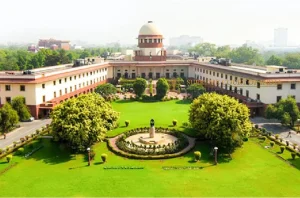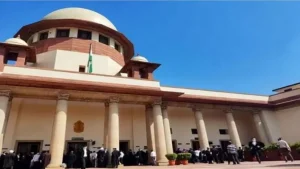

The Inevitability Of Reforming Oral Arguments In Our Courts
- /
- Articles and Blogposts /
- The Inevitability Of Reforming Oral Arguments In Our Courts
Of the several factors that are attributed to the problem of judicial delays in our country, the Supreme Court has, in two recent instances, highlighted lengthy oral arguments by lawyers as being one of the significant contributor. In a postscript in the Facebook – Delhi Assembly case, while observing that the courtroom has “become a competing arena of who gets to argue for the longest time”, the Bench emphasized the need to restrict the time period for oral submissions by lawyers. It observed that counsels must have clarity on the contours of their submissions from the inception of the arguments which should be submitted as a brief synopsis and then strictly adhered to.[1] In another case related to the revocation of senior designation of advocate Yatin Oza, the SC laid out the exact number of minutes that the advocates would be allowed to argue for and also set out the limit to the number of pages in the synopsis. The Court also stated that it will not permit multiple counsels to argue and directed that no more than one judgement be cited per proposition in their submissions.[2] These developments have re-ignited the debate on restricting oral arguments by fixing a time limit.
Oral arguments are entrenched in the Anglo-Saxon legal culture since centuries and provide “an unparalleled opportunity for litigants, through counsel, to face those who will decide their fate, for lawyers to make certain that their arguments are understood, and for judges to understand the facts, legal arguments, and human dimensions of the case to be decided.”[3] However, oral arguments have undergone significant changes in several jurisdictions driven largely by increasing caseloads, technology, and innovation. In the United States the problem of a large number of frivolous petitions for re- hearing (similar to review) provoked the court into framing restrictive rules where oral arguments are rigidly limited in duration (30 minutes per side in the Supreme Court [4]). In the High Court of Australia, the applicant and respondent have 20 minutes each for presenting oral arguments, with an additional 5 minutes to the applicant for reply.[5]
In India too, a five-judge bench of the SC in 1980 held that the court must retain a flexible power in regard to limiting the time of oral arguments or, in exceptional cases, eliminating orality altogether, the paramount principle being fair justice. Though the Court recognized that the right to be heard is a natural justice principle, it did not accede to the proposition that an oral hearing is mandatory in all classes of cases and at every stage of every case. The mode of ‘hearing’, whether it should be oral or written or both, whether it should be full-length or rationed, must depend on myriad factors and future developments.[6]
Thereafter, the 99th Report of the Law Commission considered whether the time taken in oral arguments at the higher courts could be reduced to not only secure speedy disposal but also improve the quality of presentation made before the courts. The Commission concluded that it was not possible to lay down any rigid or mathematically precise time limit for oral arguments, however, the court could obtain an estimate of the time that may be reasonable required for oral arguments from the counsels and request them to adhere to it. While no formal amendment of the law was envisaged, the Report (from 1984) recommended that a practice should be evolved to keep oral arguments within reasonable limits and be constantly followed. Thirty-eight years since, the tendency to take off into lengthy verbal duels and rabid oratory continues to contribute much to the delay and arrears in our courts.[7] As of 2 August 2021, 69,476 cases were pending in the Supreme Court.[8] In the subordinate judiciary, around 13.74 lakh cases are at the stage of arguments as of 31 July 2021. [9] The average number of days between hearings in subordinate courts at the argument stage of the proceedings is 31.25 days for civil cases and 29.25 days for criminal cases.[10]
Based on the data that was recorded and collected on a day to day basis between January 2017 and December 2018 from certain identified pilot courts in Delhi, a DAKSH study looked at the average time spent by courts on various stages of the proceedings, including final arguments.[11] It was also observed that even though prosecution evidence stage (in criminal cases) and miscellaneous cases/purpose (in civil cases) occupies the most percentage of hearings, however in terms of time courts tend to spend more minutes on the final arguments and the final order/judgments stage.[12]

There is a belief among several judges, particularly those with high caseloads, that the cost of oral arguments in terms of judicial and lawyer time, money, and decisional delay usually outweighs the benefits, especially if the time is spent merely listening to a recitation of what was said in the written submissions. Others believe that the logic that a lawyer can respond better orally to an unanticipated question, under the pressures of a personal appearance in a public courtroom, relying exclusively on memory, then in a written brief which the counsel has had ample opportunity to prepare, with full access to the record and to the texts of relevant cases, is absurd. In a 2018 study on the analysis of causes for pendency in High Court and subordinate courts in Maharashtra, researchers sought the views of judges and advocates on whether they prefer written submissions over oral arguments to save time and if fixed time limits, of 30 minutes or other appropriate amount, should be set for oral arguments. Around 70% of participating judges and 50% of the participating advocates responded in the affirmative.[13]
Moreover, unlike early days, the importance of oral argument in furnishing information is greatly reduced in the modern-day court which has access to plentitude sources of information about the issues which come before it in the form of well-developed judicial precedents, policy prescriptions, legal and scholarly commentaries, well equipped libraries, written submissions of the parties and amicus curiae, and a staff of law clerks to assist in analyzing those materials. It is high time that meaningful reforms are undertaken to preserve the best elements of oral arguments while minimizing its inherent inefficiencies.
Selecting cases worthy of oral arguments: The chorus of voices questioning the wisdom of conducting oral argument in every case has grown loud and many have advocated screening cases for oral arguments. Some of the criteria which could be used to identify such cases are presence of novel issues, complex issues, extensive records, numerous parties etc. Screening will ensure not only efficient allocation of the Court’s limited time and resources but also reduce litigation costs incurred by the parties.
Providing questions to the parties in advance: Another solution that has been adopted in some jurisdictions[14] is alerting the parties in advance of oral argument to areas of concern to the judges by including specific questions that may be asked at oral argument in a pre-argument notice. The idea is that, by instructing the parties to be ready to address specific topics or questions, the lawyers have a chance to reflect on the questions beforehand. This, in turn, promotes a more complete understanding of the case by the judges.
Improving advocacy skills: It is important to recognize that the Court do not desire a speech from the advocate, but expect help in resolving the case according to their own needs. The Court views the lawyer as an information resource rather than an orator. Hence, lawyers must bear in mind that the amount of questioning can be unpredictable, and that the argument must therefore shift from a prepared presentation to a spontaneous dialogue with the Court. He/she must identify in advance the few important points that need to be made. The oral arguments should concentrate on the substantive points and reasons as to why their client is entitled to win the case and the technical arguments should generally be left to the written submissions.
Written synopsis of oral arguments: A written synopsis of oral arguments can be presented to the Court before the date fixed for oral arguments. The lawyers should confine themselves to the points made in the synopsis during oral arguments, in order to save the court’s time. On the date of arguments, by the time one side finishes their arguments, there is usually very less or no time to listen to the other side on the same day and so when the arguments of the other side are taken up on another date, the lawyer for the first side is forced to repeat his arguments for the benefit of the judge who has lost continuity. Therefore, presenting a synopsis of the arguments beforehand will obviate the need for such repetition. This will however require extra effort on the part of the judge who must read the arguments beforehand and allow the lawyer to be as brief as possible, merely eliciting the points made in the written draft. At present, the requirement to submit written arguments in support of the case prior to concluding oral arguments is voluntary for the parties under the Code of Civil Procedure, 1908 except in cases of commercial disputes under the Commercial Courts Act, 2016 wherein it is mandatory to submit written arguments four weeks prior to oral submissions. [15]
We must keep in mind that every additional minute spent in hearing argument in one case is a minute spent not working on another case. The extra time spent on one case obviously delays justice in the other cases on the judge’s docket. Judicial delay has other costs as well. Most notably, it discourages people with potentially meritorious claims from filing a case, at a time when inadequate access to our justice system is already a critical problem. However, there is no doubt that oral arguments also hold several advantages – dynamism, flexibility, and responsiveness in presenting the argument; attention to non-rational (and often emotional) aspects of a decision; a greater sense of transparency and public visibility, litigant participation, and judicial engagement. Thus, oral arguments, if done right with prepared lawyers and prepared judges, and done with the right kind of cases, can help us maximize these benefits, and outweigh the costs.
[1] Ajit Mohan v. Legislative Assembly, National Capital Territory of Delhi, Writ petition (C) No.1088 of 2020, 8 July 2021
[2] Yatin Narendra Oza v. High Court of Gujarat, Writ Petition (Civil) No. 734/2020, Order dated 28 July 2021
[3] David R. Cleveland & Steven Wisotsky, The Decline of Oral Argument in the Federal Courts of Appeals: A Modest Proposal for Reform, 13 Journal of Apellate Practice and Process, 119, 148 (2012); accessible at: https://lawrepository.ualr.edu/appellatepracticeprocess/vol13/iss1/8
[4] Rule 28, Rules of the Supreme Court of the United States; accessible at: https://www.supremecourt.gov/ctrules/2019RulesoftheCourt.pdf
[5] Rule 41.08.3, High Court Rules 2004, High Court of Australia; accessible at: http://classic.austlii.edu.au/au/legis/cth/consol_reg/hcr2004170/s41.08.html
[6] P. N. Eswara Iyer v. The Registrar, Supreme Court Of India, 1980 SCR (2) 889
[7] Law Commission of India, 99th Report on Oral and Written Arguments in the High Courts, April 1984; accessible at: https://lawcommissionofindia.nic.in/51-100/Report99.pdf
[8] Statistics, Monthly Pending Cases, Types of matters pending in Supreme Court of India accessible at: https://main.sci.gov.in/statistics [9] DAKSH Database, accessible at: https://www.dakshindia.org/login-to-database/ [10] DAKSH Database, accessible at: https://www.dakshindia.org/login-to-database/
[11] DAKSH, Zero Pendency Courts Project, Final Report on the Pilot Project by High Court of Delhi; available at: https://www.dakshindia.org/wp-content/uploads/2019/05/PublicNotice_3MRRIN3QTHN.pdf
[12] DAKSH, Zero Pendency Courts Project, Final Report on the Pilot Project by High Court of Delhi, pg. 41; available at: https://www.dakshindia.org/wp-content/uploads/2019/05/PublicNotice_3MRRIN3QTHN.pdf
[13] Dushyant Mahadik, Analysis of Causes for Pendency in High Courts and Subordinate Courts in Maharashtra, Submitted to Department Of Justice Government Of India, January 2018; accessible at: https://doj.gov.in/sites/default/files/ASCI%20Final%20Report%20Page%20641%20to%20822.pdf
[14] The Tennessee Supreme Court occasionally avails itself of this practice, and the Tennessee Workers’ Compensation Appeals Board has a rule specifically contemplating pre-argument questions.
[15] Rule 2, Order XVIII, Code of Civil Procedure, 1908
The views expressed in this article are solely those of the authors and they do not represent the views of DAKSH.

Aakanksha Mishra
RECENT ARTICLES


Lessons for Judiciary from Space Sector

The missing piece in India’s reform story—a strong tribunal system

Fast-track courts may not be the cure

-
Rule of Law ProjectRule of Law Project
-
Access to Justice SurveyAccess to Justice Survey
-
BlogBlog
-
Contact UsContact Us
-
Statistics and ReportsStatistics and Reports
© 2021 DAKSH India. All rights reserved
Powered by Oy Media Solutions
Designed by GGWP Design